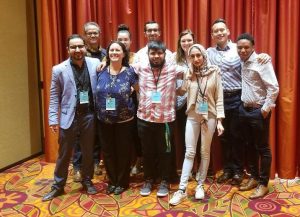The SPARC Innovator Award is an initiative that recognizes an individual, institution, or group that exemplifies SPARC principles by working to challenge the status quo in scholarly communication for the benefit of researchers, libraries, universities, and the public. SPARC Innovators are featured on the SPARC website semi-annually.
View previous SPARC Innovators | View selection criteria for SPARC Innovators
February 2020 Innovator: OpenStax
Drew Carter was in high school in southern Maryland when he discovered the value of OpenStax. He used the Houston-based nonprofit publisher’s online economic textbook to supplement what he was learning in class. Carter saw that it was produced at a place he had never heard of before – Rice University – and was intrigued.
Now a sophomore at Rice studying sociology, the first-generation college student has a dream of opening a legal clinic for low-income clients. Carter says some students drop classes when they realize they can’t afford the $200 textbook. Serving as an intern at OpenStax, he hopes to encourage transparency about course costs in the college catalog to promote broader adoption of the free, open materials and close gaps in education.
“I’m learning how OpenStax is so flexible, accommodating and is removing access barriers,” says Carter.
OpenStax began just over two decades ago as a repository of open educational resources (OER) called Connexions where faculty around the world could publish, share, and remix educational materials. In 2012, it rebranded and started publishing its own line of free, peer-reviewed textbooks as a nonprofit educational initiative.
Since then, 9 million students have used OpenStax books saving them nearly one billion dollars. Its books have been adopted in 6,900 schools and used in more than 100 countries. This spring, an estimated 3.2 million students and 24,000 faculty are using use the books – with the volume increasing by 50 to 100 percent every year.
For its work as a leader in the open education space, driving awareness, embracing diverse voices and helping make college more affordable, SPARC has recognized OpenStax with its February 2020 Innovator Award.
“OpenStax is a true ‘open’ community success story,” says SPARC Executive Director Heather Joseph. “It started by tackling a problem that was vexing teachers and learners alike, and has gone on to set the bar higher for how education publishers can deliver value for students. OpenStax represents a key piece of open infrastructure within the academic community.”
Vision for a new solution
The idea for what would become OpenStax began in the fall of 1999 when Richard Baraniuk was teaching an engineering course at Rice University. He says he was frustrated that existing textbooks would explain a topic in only one particular way, yet there wasn’t one particular way to explain a topic that would work for all students. Baraniuk felt that traditional proprietary print books weren’t designed for the various ways that students learn — he wanted a new model that would better help students. He envisioned something dynamic that would convey concepts in different and interesting ways.
“I thought why not tear the pages out and turn them into web pages?” recalls Baraniuk. “They would be free so everyone could get access, and also open source so a community could generate the material, add to it, and curate it over time.”
Twenty years ago, Baraniuk’s vision was ahead of its time.
“This was before Wikipedia, MIT OpenCourseWare, or Creative Commons, so it was really fun to have a blank slate to think about all of these things,” he says. “We were lucky to get some bootstrap funding to be able to start realizing the dream.”
The Great Recession saw textbook costs topping $300 per title, putting additional pressure on student finances and spurring support for more affordable options. At first, many were skeptical of OER, viewing it as difficult to use and requiring energy for faculty to put their content online.
While the organization expanded in the first decade, this skepticism forced it to rethink its approach. Books didn’t just emerge; they had to be built. “We could not wait for the community to develop all the learning materials; we needed to prime the pump,” says Baraniuk.
Shifting the strategy
In 2012, OpenStax launched and began to produce its own content. Daniel Williamson, managing director of OpenStax, says the idea was to make “turn-key” textbooks that were attractive to professors.
Support came from the William and Flora Hewlett Foundation and the Bill & Melinda Gates Foundation, among others. OpenStax now employs 80, most of whom are on the Rice campus in Houston. As founder, Baraniuk now serves as director overseeing the organization and Williamson runs day-to-day operations.
“The growth is because of pent up demand for access and opportunity,” says Williamson, who has been with OpenStax since 2008. “Students were clamoring for this. It was the right solution and the right time.”
Anyone now can access the entire OpenStax library free online and professors get access to instructor materials like test banks and lecture slides. Students can choose how they want to view the book – online, download a PDF, or purchase a low-cost hard copy.
OpenStax textbook projects are developed and peer-reviewed by educators to make sure they are accurate and meet requirements of each course. With philanthropic backing, OpenStax is committed to always having its books be available online completely free. All textbook content is licensed under a Creative Commons Attribution License.
OpenStax focuses on creating textbooks for the highest enrollment degree programs and currently has 38 books in its library. It recently developed adaptive courseware technology that wraps around its textbooks to support personalized learning and interactive homework.
Tapping the power of student stories
As awareness of OpenStax among faculty increased, so did demand. But the organization also began to leverage the power of individual student stories. Rather than attracting authors, the focus shifted to serving students.
“Our mission is to help students,” Williamson says. “There is a lot of passion when we look at our world and ways to break down barriers for students. Foundations and individuals in our organization are super committed to seeing this change that they wish they had in college.”
OpenStax rolled out a “Textbook Heroes” campaign that identified visionary faculty who were searching for an answer to help students. They shared how their students were often forced to choose between buying books or groceries. “There was tremendous stress in the system,” Baraniuk says. “The faculty could relate to their stories and it was very powerful.”
To further support this, OpenStax established a national internship program to bring together students to advocate for OER last fall. The diverse group includes first-generation students, international students, non-traditional students and some who are parents. Often framing access as an issue of social justice and equity, they are blogging and designing projects on their campuses to promote OER.
“We were trying to offer our platform to these students and make it possible for their voices to be amplified,” Williamson says. “They are showing us where we need to be looking as we seek to provide solutions.”
Barbara Gooch of Sparta, Tennessee, was one of 10 OpenStax interns selected in the inaugural class. After raising four children (ages 19 to 26) Gooch has enrolled at Volunteer State Community College. Her husband and children are in college now – six first-generation college students — all fans of OpenStax because of its potential for savings and the flexibility OpenStax books provide. Gooch says she appreciates that OpenStax understands that some students prefer using print and offers a low-cost paper textbook option.
She followed the organization on Facebook and is learning more about OER through the weekly virtual meetings and interacting with her fellow interns. As she is blogging about her experience, she hopes to spread the word on her campus about how OER works and can benefit students.
“While I was aware of OpenStax, I wasn’t aware of how colleges decide on textbooks and that process was interesting,” Gooch says. “I’ve enjoyed the opportunity to write, give my opinions and get involved to help more students.”
Gooch says she admires how OpenStax has expanded to bring down the cost of college for so many students and she appreciates the chance to be a small part of its efforts moving forward: “It has opened so many doors I did not expect.”
Improving outcomes
College of the Canyons, with campuses in Canyon County and Valencia, California, became an OpenStax institutional partner in 2016. It was looking for ways to expand OER to reduce costs for its 32,000 racially diverse students, according to Brian Weston, educational administrator and Director of Distance & Accelerated Learning.
In 2018-19, it had nearly 600 OER sections with zero textbooks costs and 100 courses using OER in lieu of commercial textbooks. The college created zero textbook cost pathways that include OER, and OpenStax materials when applicable, for students going through College of the Canyons’ Water Systems Technology, Early Childhood Education, Counseling, Communications, and Sociology programs.
“Faculty working with our OER student team have given positive feedback in their ability to curate information for students, knowing their students have access to the information, and that it is accessible in various formats,” Weston says. “Our OER impact data shows an increase of student success and completion.”
With improvements in success rates, especially among low-income students, the college estimates that OER has saved students approximately $4 million yearly in educational costs.
“OpenStax pioneered the golden standard of Open Educational Resources in education and the ability to collaborate and develop OER on a large scale,” says Weston. “OpenStax provides the educational community an open, vetted, and accessible alternative to the traditional publisher model.”
Fostering collaboration and building community infrastructure
In March, OpenStax will host its third annual Creator Fest in Houston. Faculty who are OER adopters in various disciplines gather to design ancillary materials and give their feedback in focus groups on how to improve the open textbooks.
“We believe the best way to grow the movement and the availability of supply is to bring faculty together to work to create the next generation of this content,” says Williamson. “It’s not like a conference where you sit and listen to people talk all day. It’s more of a hackathon where people are actively creating content and sharing it openly.”
As a research university, Rice provides OpenStax with critical infrastructure that makes it easy for people to take, adapt and own content to make education better all students, Williamson says.
Although growing, OER still represents a small portion of the overall textbook market. The challenge for OpenStax now is to expand its library to cover more courses. But Baraniuk maintains that with low costs of digital materials and clear benefits for faculty to customize and students to save money, the momentum is in their favor.
“The focus on learning materials should move from the bookstore to the library,” Baraniuk says. “Libraries are the natural place to curate content developed not only at their school, but through collaboration with the entire academic community, across the country and the world. That is going to be the future.”
#
-Caralee Adams

